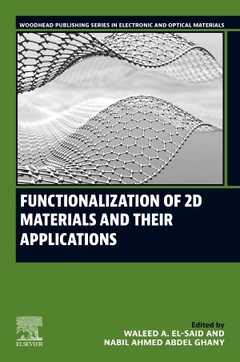Functionalization of 2D Materials and Their Applications Woodhead Publishing Series in Electronic and Optical Materials Series
Langue : Anglais
Coordonnateurs : El-Said Waleed A., Ghany Nabil Ahmed Abdel

Functionalization of 2D Materials and Their Applications reviews the synthesis and characterization of nanopatterned 2D materials and how to modify different substrates with these materials. Each chapter emphasizes fabrication, including the fabrication of different morphologies of graphene and transition metal dichalcogenides (TMDCs), the fabrication of different composites and the surface modification of different nanopatterned graphene and TMDCs, and the effects of these nanostructures on the different properties of the modified substrates, such as the electrical, thermal and optical properties, and more. The applications of graphene and TMDCs in the enhancement of Raman spectroscopy, solar cells, fuel cells, supercapacitors, biosensors, chemical sensors, water treatment, water desalination, perovskite photodetectors, energy storage devices, environmental applications and cell-based chips are also reviewed.
Part I: Synthesis of 2D materials
1. History and Current Status of 2D Materials
2. State-of-the-art design and fabrication approaches/methods of 2D materials nanopatterns
3. Recent advances in synthesis methods of mesoporous graphene and their composites
4. Design and synthesis of metal-Organic framework/graphene nanocomposites
Part II: Characterization and properties of 2D materials
5. Characterization of graphene analogues of 2D materials: challenges and opportunities
6. Functionalized hetero 2D materials-- optical, electronic, magnetic, mechanical properties
7. Computational modelling of 2D nanomaterials
8. Spin-orbit interaction and optospintronics in graphene and 2D materials
9. Anisotropic, phonon and optical properties of the 2D materials and their applications in surface-enhanced raman spectroscopy and photonic devices
Part III: Applications of functionalized 2D materials
10. Recent progress in functionalized 2D wearable and flexible nanosheets: fundamentals, synthesis, and their theoretical aspects for sensing applications: An Overview
11. Fundamentals of 2D materials for energy storage and production applications
12. Recent trends in functionalization of 2D nanomaterials as nanocontainers for capture and storage of CO2
13. Advances of 2D nanostructures-based membranes for water treatment and desalination, and radioactive pollutants removal
14. 2D materials-based scaffolds for cell-based chips and tissue engineering and their recent progress in medical applications
15. Functionalized 2D materials-based chemo/biosensors
16. Functionalized 2D materials for lab-to-fab applications
1. History and Current Status of 2D Materials
2. State-of-the-art design and fabrication approaches/methods of 2D materials nanopatterns
3. Recent advances in synthesis methods of mesoporous graphene and their composites
4. Design and synthesis of metal-Organic framework/graphene nanocomposites
Part II: Characterization and properties of 2D materials
5. Characterization of graphene analogues of 2D materials: challenges and opportunities
6. Functionalized hetero 2D materials-- optical, electronic, magnetic, mechanical properties
7. Computational modelling of 2D nanomaterials
8. Spin-orbit interaction and optospintronics in graphene and 2D materials
9. Anisotropic, phonon and optical properties of the 2D materials and their applications in surface-enhanced raman spectroscopy and photonic devices
Part III: Applications of functionalized 2D materials
10. Recent progress in functionalized 2D wearable and flexible nanosheets: fundamentals, synthesis, and their theoretical aspects for sensing applications: An Overview
11. Fundamentals of 2D materials for energy storage and production applications
12. Recent trends in functionalization of 2D nanomaterials as nanocontainers for capture and storage of CO2
13. Advances of 2D nanostructures-based membranes for water treatment and desalination, and radioactive pollutants removal
14. 2D materials-based scaffolds for cell-based chips and tissue engineering and their recent progress in medical applications
15. Functionalized 2D materials-based chemo/biosensors
16. Functionalized 2D materials for lab-to-fab applications
Dr. Waleed A. El-Said is currently an Associate Professor of Nanotechnology in the Chemistry Department at Assiut University in Egypt. At Assiut University he has established a lab on Nanobiotechnology. His research interests include the synthesis and characterization of nanomaterials and their fabrication.
Nabil A. Abdel Ghany is a group leader (full research professor) in the Physical Chemistry Department, National Research Centre (NRC), Egypt. His research interests lie in electrochemistry, nanomaterials, corrosion protection, biomaterials, and energy production, conversion, and storage.
Nabil A. Abdel Ghany is a group leader (full research professor) in the Physical Chemistry Department, National Research Centre (NRC), Egypt. His research interests lie in electrochemistry, nanomaterials, corrosion protection, biomaterials, and energy production, conversion, and storage.
- Reviews the latest advances in the approaches of the fabrication of 2D materials, including nanopatterned, composites and porous 2D materials
- Provides information on the functionalization of 2D materials, with particular attention given to electrical, thermal and optical properties which may make the material useful for a wide range of applications
- Discusses the applications of 2D materials in energy, sensing, environmental remediation and electronics
Date de parution : 06-2024
Ouvrage de 424 p.
15x22.8 cm
Thèmes de Functionalization of 2D Materials and Their Applications :
© 2024 LAVOISIER S.A.S.



